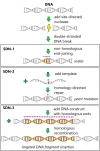Occurrence and Nature of Off-Target Modifications by CRISPR-Cas Genome Editing in Plants
- PMID: 35548699
- PMCID: PMC9075866
- DOI: 10.1021/acsagscitech.1c00270
Occurrence and Nature of Off-Target Modifications by CRISPR-Cas Genome Editing in Plants
Abstract
CRISPR-Cas-based genome editing allows for precise and targeted genetic modification of plants. Nevertheless, unintended off-target edits can arise that might confer risks when present in gene-edited food crops. Through an extensive literature review we gathered information on CRISPR-Cas off-target edits in plants. Most observed off-target changes were small insertions or deletions (1-22 bp) or nucleotide substitutions, and large deletions (>100 bp) were rare. One study detected the insertion of vector-derived DNA sequences, which is important considering the risk assessment of gene-edited plants. Off-target sites had few mismatches (1-3 nt) with the target sequence and were mainly located in protein-coding regions, often in target gene homologues. Off-targets edits were predominantly detected via biased analysis of predicted off-target sites instead of unbiased genome-wide analysis. CRISPR-Cas-edited plants showed lower off-target mutation frequencies than conventionally bred plants. This Review can aid discussions on the relevance of evaluating off-target modifications for risk assessment of CRISPR-Cas-edited plants.
© 2022 The Authors. Published by American Chemical Society.
Conflict of interest statement
The authors declare no competing financial interest.
Figures


Similar articles
-
Whole genome sequencing reveals rare off-target mutations and considerable inherent genetic or/and somaclonal variations in CRISPR/Cas9-edited cotton plants.Plant Biotechnol J. 2019 May;17(5):858-868. doi: 10.1111/pbi.13020. Epub 2018 Oct 30. Plant Biotechnol J. 2019. PMID: 30291759 Free PMC article.
-
Impact of predictive selection of LbCas12a CRISPR RNAs upon on- and off-target editing rates in soybean.Plant Direct. 2024 Aug 16;8(8):e627. doi: 10.1002/pld3.627. eCollection 2024 Sep. Plant Direct. 2024. PMID: 39157758 Free PMC article.
-
Epigenetic Footprints of CRISPR/Cas9-Mediated Genome Editing in Plants.Front Plant Sci. 2020 Jan 31;10:1720. doi: 10.3389/fpls.2019.01720. eCollection 2019. Front Plant Sci. 2020. PMID: 32117329 Free PMC article.
-
Which Factors Affect the Occurrence of Off-Target Effects Caused by the Use of CRISPR/Cas: A Systematic Review in Plants.Front Plant Sci. 2020 Nov 23;11:574959. doi: 10.3389/fpls.2020.574959. eCollection 2020. Front Plant Sci. 2020. PMID: 33329634 Free PMC article.
-
CRISPR/Cas genome editing to optimize pharmacologically active plant natural products.Pharmacol Res. 2021 Feb;164:105359. doi: 10.1016/j.phrs.2020.105359. Epub 2020 Dec 4. Pharmacol Res. 2021. PMID: 33285226 Review.
Cited by
-
Less is more: CRISPR/Cas9-based mutations in DND1 gene enhance tomato resistance to powdery mildew with low fitness costs.BMC Plant Biol. 2024 Aug 10;24(1):763. doi: 10.1186/s12870-024-05428-3. BMC Plant Biol. 2024. PMID: 39123110 Free PMC article.
-
Non-homologous end-joining-deficient filamentous fungal strains mitigate the impact of off-target mutations during the application of CRISPR/Cas9.mBio. 2023 Aug 31;14(4):e0066823. doi: 10.1128/mbio.00668-23. Epub 2023 Jul 24. mBio. 2023. PMID: 37486124 Free PMC article.
-
A platform to deliver single and bi-specific Cas9/guide RNA to perturb genes in vitro and in vivo.Mol Ther. 2024 Oct 2;32(10):3629-3649. doi: 10.1016/j.ymthe.2024.07.025. Epub 2024 Jul 31. Mol Ther. 2024. PMID: 39091030 Free PMC article.
-
Recommendations for the Assessment of Potential Environmental Effects of Genome-Editing Applications in Plants in the EU.Plants (Basel). 2023 Apr 25;12(9):1764. doi: 10.3390/plants12091764. Plants (Basel). 2023. PMID: 37176822 Free PMC article. Review.
-
CRISPR/Cas system-mediated transgene-free or DNA-free genome editing in plants.Theor Appl Genet. 2025 Aug 12;138(9):210. doi: 10.1007/s00122-025-04990-0. Theor Appl Genet. 2025. PMID: 40794116 Review.
References
Publication types
LinkOut - more resources
Full Text Sources
Research Materials
